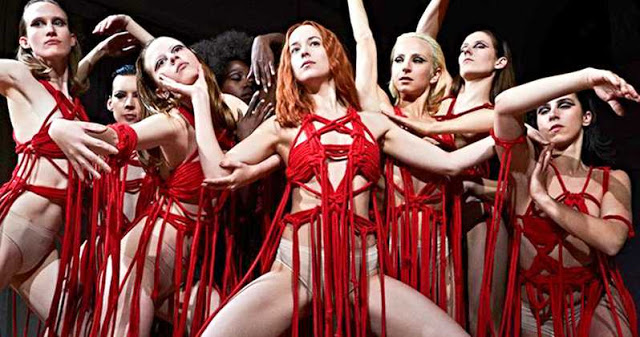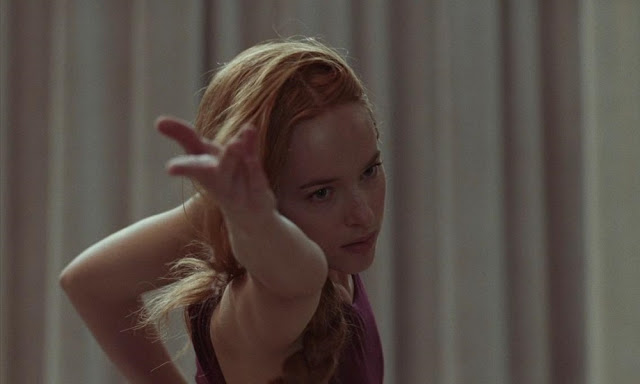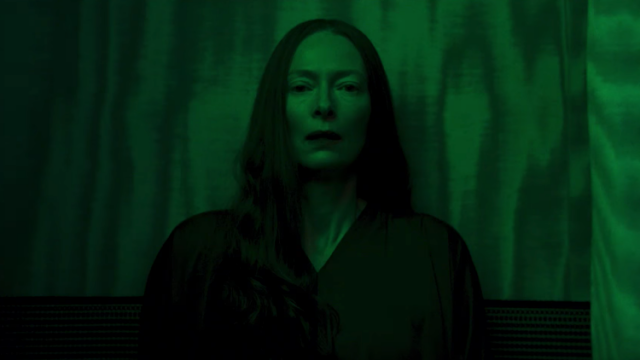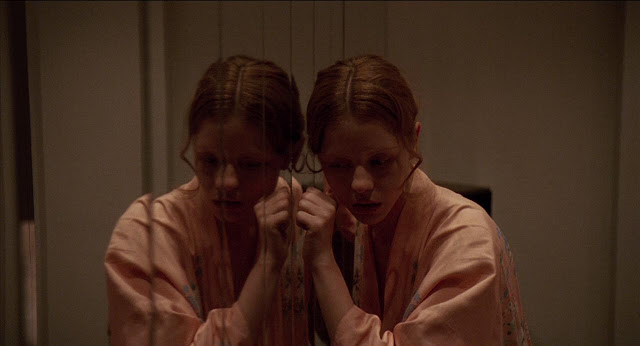Dance is death in Suspiria, Luca Guadagnino’s insane, exasperating, furiously watchable remake of Dario Argento’s 1977 cult classic. The collision of beauty and brutality on stage is hardly novel; Black Swan gave us a feral portrait of a performer who helplessly sacrificed her body and her sanity in the pursuit of artistic perfection. But Suspiria posits ballet as a more malevolent sort of blood sport, where lithe women twirl and leap and crash, all while sinister forces lurk behind the gleaming mirrors and beneath the polished floorboards, eager to feed on the talents of the young. I’m not speaking metaphorically; this really is a movie about a desiccated matriarch who craves to transplant her soul from her own befouled body into the supple flesh of an unsuspecting protégé. And you thought the battles in the Step Up franchise were intense!
Of course, Suspiria is more (or maybe less) than a gonzo supernatural thriller. “I could explain everything to you; I think that would be wrong, though,” an instructor murmurs to an unnerved pupil. I can’t explain much of anything to you, because this movie defies easy description, even as it eagerly courts post-hoc analysis. Suffice it to say that Suspiria seems to be about many things. Perhaps it’s about the intersection of political activism and grass-roots fanaticism, given that it’s set in Germany 1977 and glancingly depicts (by way of news broadcasts and radio snippets) the death knell of the Baader-Meinhof movement. Maybe it’s about femininity and solidarity, seeing as it traces the relationships—the camaraderie, the rivalries, the jealousy and admiration—of a company of female dancers at an elite academy. Maybe it’s about self-discovery; its main character, Susie Bannion (Dakota Johnson), initially enters the conservatory’s halls with timidity, only to quickly reveal herself as an ambitious and capable dancer with a hunger for stardom. Maybe it’s about the persistence of fascism; how else to explain the extensive subplot about an elderly German man searching for his wife, who’s believed to have vanished decades ago at the Concentration Camps? Or maybe it’s just about a bunch of old women who want to be young again.
Oddly enough, Suspiria isn’t really about Suspiria; Guadagnino has described his film as an homage rather than a remake. We can quibble over terminology, but as a matter of filmmaking philosophy, his approach is entirely correct. Argento’s original, perhaps the standard-bearer for Italy’s giallo cinema, is certainly a nightmarish collage of blood and color, with random jolts of ghastly invention, but its appeal largely escapes me; watching it in 2018, I found it to be a heavily stylized, woodenly acted, terribly written piece of nonsense. Guadagnino’s update, with a screenplay by David Kajganich, is only marginally more sensical—I think there may have been something about an Amish woman wilting on her deathbed in Ohio?—but while it retains Argento’s gift for provocation, it is a far more coherent and compelling work. Guadagnino may be taunting you with elusive imagery and oblique themes, but there is pleasure in the torment.
And in the dancing, which seems as deadly as it is lovely. Suspiria is replete with scenes of elastic bodies arcing gracefully through the air, but there is an alarming ferocity to Damien Jalet’s choreography, a wildness that hovers at the nexus of sex and combat. (Putting a fine point on it, when asked to describe one of her performances, the virginal Susie suggests that “it felt like what I think it must feel like to fuck”, then clarifies that she was referring to copulating not with a man, but with an animal.) When Susie first auditions at the Markos Dance Academy, red braid lashing about like a medieval flail, her limbs seem to be pummeling an invisible foe; several rooms away, the school’s headmistress, Madame Blanc (Tilda Swinton), suddenly freezes and cocks her ear, as though she can somehow sense Susie’s balletic savagery. Later, in the movie’s pièce de résistance, Susie performs a visceral rehearsal while one of her fellow students, Olga (Elena Fokina), finds herself trapped in an adjoining studio; as Susie writhes and kicks and tumbles, Olga’s body is correspondingly flung onto the floor and buffeted into walls, limbs snapping and face distending. It’s absurd, grotesque, and utterly mesmerizing.
Guadagnino’s staging of that sequence is gleefully excessive, making you feel every ugly stab of pain; by the time a troupe of impassive instructors arrive and begin methodically slashing at Olga with curved blades, it plays less like a depraved murder than a mercy killing. And throughout Suspiria, Guadagnino toys with the frame and the camera, twisting the careless-summer sensuality he brought to Call Me by Your Name into ghoulishly alluring shapes. His constant flourishes—sweeping crane shots, sudden zooms, random cutaways—are occasionally ostentatious, but they’re often legitimately ravishing. (The music, by Thom Yorke, is moody and enveloping, a dramatic departure from Goblin’s memorably assaultive score for Argento.) Suspiria always offers something to see, even when you don’t know what the hell you’re watching.
Which is most of the time. Too exotic and adventurous to be boring, Suspiria invites you to speculate about its hidden meanings, to unravel its impenetrable mysteries. Predictably a box-office dud, it is sure to be greedily devoured by cultish enthusiasts for years to come; it’s easy to imagine future college students hosting midnight dorm-room gatherings where a few media majors earnestly debate the film’s thematic connections, while their stoned friends just cackle and wince at the violence and gore. I welcome a movie that’s open to interpretation, but there’s something about Suspiria that’s frustrating, and not in the tantalizing way that Guadagnino intends. In its prideful, vertiginous insistence on building itself up into a brain-shredding horror puzzler, the movie willfully neglects some basic filmmaking essentials, refusing to bother to craft a sensible plot or, more importantly, develop interesting characters.
Susie, for example, is an archetype, the innocent soul to be ravaged and spoiled, and while the screenplay pretends to supply her with some agency—she eventually approaches her fate with fervor rather than terror—it never turns her into a real person with plausible choices or desires or fears. Johnson, who previously worked with Guadagnino on the lurching melodrama A Bigger Splash, persuasively conveys Susie’s passion, but Guadagnino robs her of the opportunity to flash the humor and slyness that she brought (in vain) to the Fifty Shades franchise. And while Swinton, Guadagnino’s muse (this is their fourth collaboration; their second, I Am Love, remains his best film), imbues her authoritative maestro with tremors of regret and self-doubt, Madame Blanc is too enigmatic to be sympathetic. Like most of her colleagues, she can communicate telepathically, but who cares what she’s saying if you can’t understand what she’s feeling?
Perhaps because Guadagnino thrusts such massive weight upon his leads, his secondary characters fare somewhat better. Sara (Mia Goth, very good), the veteran dancer who genially welcomes Susie into the academy, is a warm and lively presence, with a verifiably human center; a sequence where she wanders through the school’s catacombs, awakening long-dormant evils, induces genuine anxiety to go with the usual perverse curiosity. And perhaps the film’s craziest gambit is the mystifying figure of Josef Klemperer (I could tell you the name of the actor who plays him, but you wouldn’t believe me). Josef is a German psychiatrist who gradually becomes embroiled in the academy’s supernatural dealings, but he’s also consumed by his own obsessions and guilt, which Guadagnino reveals with admirable patience.
But this is a woman’s world. As Suspiria’s story grows increasingly unhinged, it lays bare its gender politics as well as its characters’ fetid flesh. The coven of witches that secretly operates within the school’s walls is an ancient institution, with its own peculiar codes and rituals, and it plainly has no use for men. Still, whatever statement on womanhood the movie is trying to make becomes largely muddled, obscured by its haphazard plotting and sprawling narrative. At one point, one of the instructors suddenly stabs herself in the neck (naturally, my mind drifted to Interpol), and while it’s an impressively gruesome scene, the clamor it generates feels oddly distant, because you have little idea who killed herself, much less why.
With its hairpin turns and its bouts of illogic, Suspiria can be maddening. Yet even as it threatens to burst apart at the seams, it remains for the most part deliriously entertaining. A late performance of a ballet, called “Volk” by Madame Blanc, is baffling in its details, but it’s undeniably eye-catching, the dancers’ blood-red threads accentuating their rippling movements. Only in the Grand Guignol climax—when one character literally bursts apart at the seams—does Guadagnino’s monumental ambition fully defeat him; the culmination of the film’s slow-building nightmare is so outrageous, so grandiose, all that’s left to do is laugh. Until then, however, Suspiria’s intensity is hard to shake. Much like Susie, you may find yourself spellbound, powerless to resist as this elegant, pitiless fever dream of a movie takes your hand and tugs, pulling you down with it as it descends, fearlessly and stupefyingly, into the bowels of Hell.
Jeremy Beck is the editor-in-chief of MovieManifesto. He watches more movies and television than he probably should.




